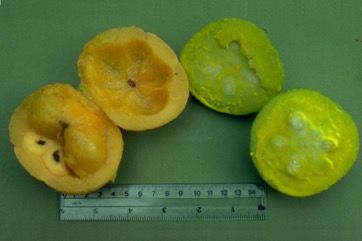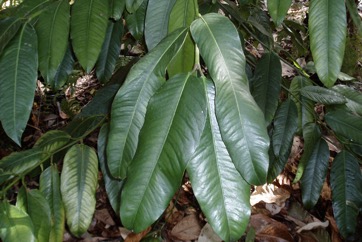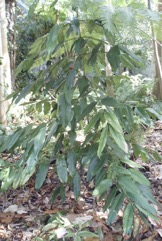Egg tree, Mundu mangosteen

A tropical plant. It suits the hot, wet tropical lowlands. They are common and widely distributed in the Philippines from northern Luzon to the southern part growing in primary forest at low and medium altitudes. It grows in coastal areas up to 500 m altitude. It is not particular as regards soil.
Also known as:
Bagalot, Baniti, Baros, Buneg, Claudie Mangosteen, Gledog panto, Gourka, Jawura, Madaw, Maphut, Moendoe, Mundu, Pohon manggis mundu, Rata, Taklang-anak
Synonyms
- Garcinia longifolia Bl.
- Stalagmitis dulcis Cambess
- Stalagmitis javanensis Spach
- Xanthochymus dulcis Roxb.
- Xanthochymus javanensis Bl.
Edible Portion
- Fruit
Where does Egg tree grow?
Found in: Asia, Australia, Cuba, Fiji, India, Indochina, Indonesia, Malaysia, Myanmar, Pacific, Papua New Guinea, PNG, Philippines, SE Asia, Suriname, Thailand
Notes: There are about 300 Garcinia species.
Status: At present not commonly planted in Papua New Guinea.
Growing Egg tree, Mundu mangosteen
Cultivation: Trees are grown from seed. Seed need to be sown while fresh. Trees can be budded or grafted. Shield budding on fairly mature wood using large buds is best.
Edible Uses: The fleshy portion of the fruit is eaten raw. They are a bit acid. They can be cooked. They can be used to make jam. They are also used for drinks and candied or dried.
Production: Fruit production is seasonal about Dec to May in the Southern Hemisphere.
Nutrition Info
per 100g edible portion| Edible Part | Energy (kcal) | Protein (g) | Iron (mg) | Vitamin A (ug) | Vitamin c (mg) | Zinc (mg) | % Water |
|---|---|---|---|---|---|---|---|
| Fruit | 49 | 0.4 | 0.4 | 25 | 5 | - | 86.7 |
Egg tree, Mundu mangosteen Photos



References
Egg tree Garcinia dulcis references
Alain & Martorell. 1982. Flora of Puerto Rico.
Ambasta, S.P. (Ed.), 2000, The Useful Plants of India. CSIR India. p 230
Arora, R. K., 2014, Diversity in Underutilized Plant Species - An Asia-Pacific Perspective. Bioversity International. p 72
Backer & Bakh. f. 1963-1968. Flora of Java.
Barwick, M., 2004, Tropical and Subtropical Trees. A Worldwide Encyclopedic Guide. Thames and Hudson p 195
Brown, W.H., 1920, Wild Food Plants of the Philippines. Bureau of Forestry Bulletin No. 21 Manila. p 122
Burkill, I.H., 1966, A Dictionary of the Economic Products of the Malay Peninsula. Ministry of Agriculture and Cooperatives, Kuala Lumpur, Malaysia. Vol 1 (A-H) p 1066
Cherikoff V. & Isaacs, J., The Bush Food Handbook. How to gather, grow, process and cook Australian Wild Foods. Ti Tree Press, Australia p 200
Cooper, W. and Cooper, W., 2004, Fruits of the Australian Tropical Rainforest. Nokomis Editions, Victoria, Australia. p 122
Coronel, R.E., 1982, Fruit Collections in the Philippines. IBPGR Newsletter p 10
Darley, J.J., 1993, Know and Enjoy Tropical Fruit. P & S Publishers. p 45
Elliot, W.R., & Jones, D.L., 1992, Encyclopedia of Australian Plants suitable for cultivation. Vol 4. Lothian. p 330
Encke, F., et al. 1984. Zander: Handworterbuch der Pflanzennamen, ed. 13.
Facciola, S., 1998, Cornucopia 2: a Source Book of Edible Plants. Kampong Publications, p 79
Flowerdew, B., 2000, Complete Fruit Book. Kyle Cathie Ltd., London. p 161
French, B.R., 1986, Food Plants of Papua New Guinea, A Compendium. Asia Pacific Science Foundation p 266
Hedrick, U.P., 1919, (Ed.), Sturtevant's edible plants of the world. p 323
J. Asiat. Soc. Bengal, Pt. 2, Nat. Hist. 43(2):88. 1874
Lembaga Biologi Nasional, 1977, Buah-Buahan, Balai Pustaka, Jakarta. p 92
Liberty Hyde Bailey Hortorium. 1976. Hortus third.
Macmillan, H.F. (Revised Barlow, H.S., et al) 1991, Tropical Planting and Gardening. Sixth edition. Malayan Nature Society. Kuala Lumpur. p 301
Maheswari. 1974. Bull. Bot. Surv. India 6:115-116.
Martin, F. W., et al, 1987, Perennial Edible Fruits of the Tropics. USDA Handbook 642 p 29
Merr. 1922-1926. An enumeration of Philippine flowering plants.
Miguel, E., et al, 1989, A checklist of the cultivated plants of Cuba. Kulturpflanze 37. 1989, 211-357
Milow, P., et al, 2013, Malaysian species of plants with edible fruits or seeds and their evaluation. International Journal of Fruit Science. 14:1, 1-27
Monsalud, M.R., Tongacan, A.L., Lopez, F.R., & Lagrimas, M.Q., 1966, Edible Wild Plants in Philippine Forests. Philippine Journal of Science. p 481
PROSEA (Plant Resources of South East Asia) handbook, Volume 2, 1991, Edible fruits and nut. p 175
Purseglove, J.W., 1968, Tropical Crops Dicotyledons, Longmans. p 634
Smith, A.C., 1981, Flora Vitiensis Nova, Lawaii, Kuai, Hawaii, Volume 2 p 347
Smith & Darwin. 1974. J. Arnold Arbor. 55:261.
St. John, H., 1973. List and summary of the flowering plants in the Hawaiian islands.
Terrell et al. 1986. Agric. Handb. no. 505.
Townsend, K., 1994, Across the Top. Gardening with Australian Plants in the tropics. Society for Growing Australian Plants, Townsville Branch Inc. p 221
USDA, ARS, National Genetic Resources Program. Germplasm Resources Information Network - (GRIN). [Online Database] National Germplasm Resources Laboratory, Beltsville, Maryland. Available: www.ars-grin.gov/cgi-bin/npgs/html/econ.pl (10 April 2000)
Verheij, E. W. M., and R. E. Coronel, eds. 1991. Edible fruits and nuts. In: E. W. M. Verheij & R. E. Coronel (eds.), Plant Resources of South-East Asia (PROSEA). 2:175.
Walter, A. & Sam C., 2002, Fruits of Oceania. ACIAR Monograph No. 85. Canberra. p 177
World Checklist of Useful Plant Species 2020. Royal Botanic Gardens, Kew
Zawiah, N. & Othaman, H., 2012, 99 Spesies Buah di FRIM. Institut Penyelidikan Perhutanan Malaysia. p 128